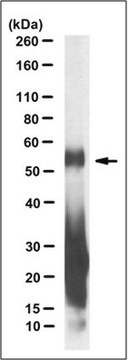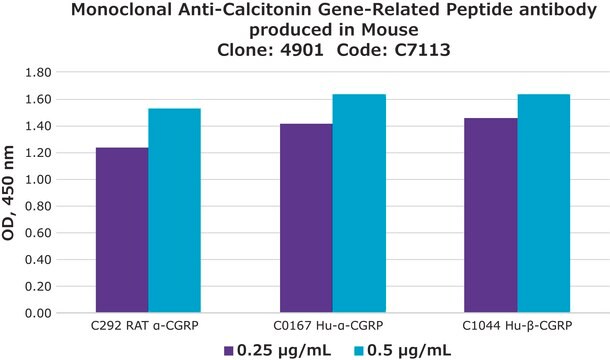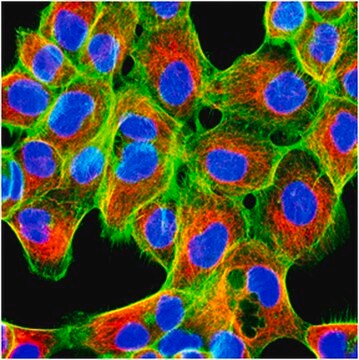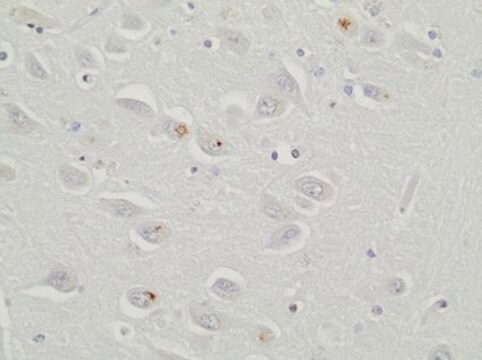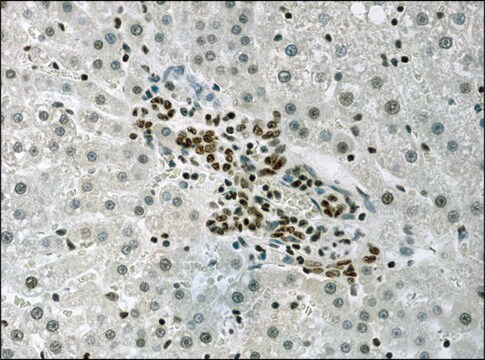ABN1361
Anti-C9ORF72/C9RANT (Poly-GR)
serum, from rabbit
Synonym(e):
C9ORF72/C9RANT (poly-GR), alpha-GR-sense, Poly-GR, Poly-RG
About This Item
Empfohlene Produkte
Biologische Quelle
rabbit
Qualitätsniveau
Antikörperform
serum
Antikörper-Produkttyp
primary antibodies
Klon
polyclonal
Speziesreaktivität
human
Methode(n)
immunocytochemistry: suitable
immunofluorescence: suitable
immunohistochemistry: suitable
western blot: suitable
NCBI-Hinterlegungsnummer
UniProt-Hinterlegungsnummer
Versandbedingung
ambient
Posttranslationale Modifikation Target
unmodified
Allgemeine Beschreibung
Spezifität
Immunogen
Anwendung
Neurowissenschaft
Immunohistochemistry Analysis: A representative lot detected C9ORF72/C9RANT (Poly-GR) in aggregates found in neurons of the CA and DG regions of the hippocampus (Zu, T., et. al. (2013). Proc Natl Acad Sci USA. 110(51):E4968-77).
Immunofluorescence Analysis: A representative lot detected C9ORF72/C9RANT (Poly-GR) in V5-GR-Ct Transfected HEK293T (Zu, T., et. al. (2013). Proc Natl Acad Sci USA. 110(51):E4968-77).
Immunocytochemistry Analysis: A 1:500 dilution from a representative lot detected C9ORF72/C9RANT (Poly-GR) in V5-GR-Ct transfected HEK293. (Courtesy of Dr Laura P.W. Ranum and Dr. Lien Nguyen from the University of Florida).
Qualität
Western Blotting Analysis: A 1:1,000 dilution of this antibody detected C9ORF72/C9RANT (Poly-GR) in 10 µL of lysate from HEK293 cells transfected with Flag-GR construct.
Zielbeschreibung
Physikalische Form
Lagerung und Haltbarkeit
Handling Recommendations: Upon receipt and prior to removing the cap, centrifuge the vial and gently mix the solution. Aliquot into microcentrifuge tubes and store at -20°C. Avoid repeated freeze/thaw cycles, which may damage IgG and affect product performance.
Sonstige Hinweise
Haftungsausschluss
Sie haben nicht das passende Produkt gefunden?
Probieren Sie unser Produkt-Auswahlhilfe. aus.
Lagerklassenschlüssel
12 - Non Combustible Liquids
WGK
WGK 1
Analysenzertifikate (COA)
Suchen Sie nach Analysenzertifikate (COA), indem Sie die Lot-/Chargennummer des Produkts eingeben. Lot- und Chargennummern sind auf dem Produktetikett hinter den Wörtern ‘Lot’ oder ‘Batch’ (Lot oder Charge) zu finden.
Besitzen Sie dieses Produkt bereits?
In der Dokumentenbibliothek finden Sie die Dokumentation zu den Produkten, die Sie kürzlich erworben haben.
Unser Team von Wissenschaftlern verfügt über Erfahrung in allen Forschungsbereichen einschließlich Life Science, Materialwissenschaften, chemischer Synthese, Chromatographie, Analytik und vielen mehr..
Setzen Sie sich mit dem technischen Dienst in Verbindung.


